Browse Exhibits (6 total)
Critiquing Western Interpretations of Northern People

Primary sources are defined as first-hand testimony or direct evidence concerning the topic being explored. They are created by witnesses or recorders who experience the events or conditions being documented. However, it is important to take into account the perspective of the individual documenting the event. The Jesuits in the Northern Native communities experienced events, customs, and ceremonies with minimal or no knowledge about the event occurring. In other words the Jesuit journals and photographs were taken documented through an outsider’s perspective. At the most the Native people being “observed” helped the Jesuit documenting spell out their name. However, most of the photos taken do not contain names or descriptions. Even after living with the Native people for a period of time many of the Jesuits believed the Northern Native people to be savages with no purpose in life, who would be condemned, and therefore needed their salvation. This discrimination is seen throughout documentation, therefore making it difficult to verify description of people and customs.
King Islanders: Fur Trade and Mixed Race Families
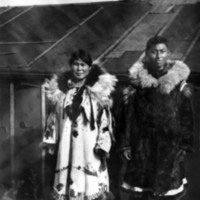
The photographs in this exhibit and much of the background research that accompanies it come the archives of the the Oregon Province of Jesuits. This exhibit also drew from the writings of Paul Tiulana, a King Islander born in 1921 on the island who wrote in the 1980s about his community's heritage. Thus, with the exception of Tiulana's writings, much of the information about and all of the images of the King Islanders presented here come to us through a Jesuit perspective.
This exhibit will focus primarily on the fur trade that was going on during this time and its impact on the King Islanders. The impact of the fur trade was seen not only through the clothing that it produced but also through the conflict that it brought. While the fur trade did provide a means for intercultural communication and revenue, it also brought forth the following: disease, alcohol, death of native trappers, and the depletion of native fur-bearing animal populations.
Cultural Change in the King Island Community
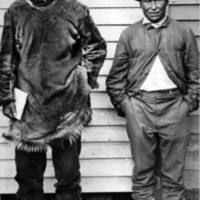
The photographs in this exhibit come from the archives of the Oregon Province of Jesuits housed at Gonzaga University. Information for this exhibit has been drawn from letters and journals of Father Bellarmine Lafortune, S.J. who lived amongst the King Islander community. His main goal was to bring Catholicism to the indigenous community. King Islanders had been isolated from white culture prior to the Nome Gold Rush of 1898 and this collection captures images of the period of transition that ensued.
This exhibit highlights photographs that reveal the tension formed by the Jesuits entering the King Island community and bringing entirely new religious and cultural ideas with them. The documents cited in this exhibit are written from a Jesuit perspective and reveal the inherent biases that the white people had against these indigenous peoples.
Special Collections at Santa Clara University have also digitized photographs of the King Islanders. For images taken by Bernard Hubbard, S.J. see: https://content.scu.edu/cdm/landingpage/collection/kingisland
Much of those photographs are from mid-twentieth century. Thus the Treca collection here are some of the earliest archival photographs of the King Island community.
Children as Catalyst of Conversion
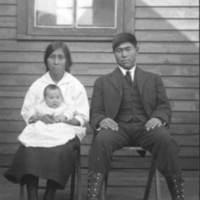
When the Jesuits came to King Island in the early 1900s, they largly focused on the children as an entry point for westernizing and converting the entire community to Catholocism.
The photographs in this exhibit and much of the background research that accompanies them come the archives of the the Oregon Province of Jesuits. This exhibit also drew from the writings of Paul Tiulana, a King Islander born in 1921 on the island who wrote in the 1980s about his community's heritage. Thus, with the exception of Tiulana's writings, much of the information about and all of the images of the King Islanders presented here come to us through a Jesuit perspective. The diary of LaFortune, S.J. was referenced, in addition to newspaper clippings from Washington State from the same time period.
This is a collection of photographs taken by Jesuit Joseph M. Treca in 1916. The photographs provide a snapshot of the King Islander community while they were in Nome.
Transitions of the Church
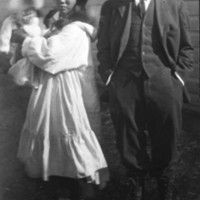
The photographs in this exhibit and much of the background research that accompanies them come the archives of the the Oregon Province of Jesuits. This exhibit also drew from the writings of Paul Tiulana, a King Islander born in 1921 on the island who wrote in the 1980s about his community's heritage. Thus, with the exception of Tiulana's writings, much of the information about and all of the images of the King Islanders presented here come to us through a Jesuit perspective.
This is a collection of photographs taken by Jesuit Joseph M. Treca in 1916. The photographs provide a snapshot of the King Islander community while they were in Nome.
King Island is about 40 miles off the coast of Alaska and 90 miles northwest of Nome. The first twenty years of the twentieth century was a time of change for this area. Following the Nome Gold Rush of 1898, whites came en masse to an area that had been relatively isolated from white culture beforehand. Thus, these photographs capture a community in a period of change.
Special Collections at Santa Clara University have also digitized photographs of the King Islanders. For images taken by Bernard Hubbard, S.J. see: https://content.scu.edu/cdm/landingpage/collection/kingisland
Much of those photographs are from mid-twentieth century. Thus the Treca collection here are some of the earliest archival photographs of the King Island community.
King Islanders
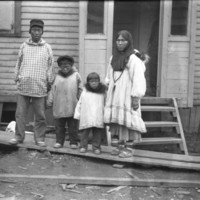
The photographs in this exhibit and much of the background research that accompanies them come the archives of the the Oregon Province of Jesuits. This exhibit also drew from the writings of Paul Tiulana, a King Islander born in 1921 on the island who wrote in the 1980s about his community's heritage. Thus, with the exception of Tiulana's writings, much of the information about and all of the images of the King Islanders presented here come to us through a Jesuit perspective.
This is a collection of photographs taken by Jesuit Joseph M. Treca in 1916. The photographs provide a snapshot of the King Islander community while they were in Nome.
King Island is about 40 miles off the coast of Alaska and 90 miles northwest of Nome. The first twenty years of the twentieth century was a time of change for this area. Following the Nome Gold Rush of 1898, whites came en masse to an area that had been relatively isolated from white culture beforehand. Thus, these photographs capture a community in a period of change.
Special Collections at Santa Clara University have also digitized photographs of the King Islanders. For images taken by Bernard Hubbard, S.J. see: https://content.scu.edu/cdm/landingpage/collection/kingisland
Much of those photographs are from mid-twentieth century. Thus the Treca collection here are some of the earliest archival photographs of the King Island community.
